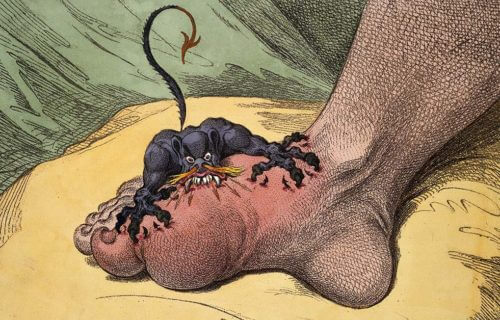SAN DIEGO — A new treatment for gout could be on the horizon. International research led by University of California San Diego School of Medicine has identified a novel molecular pathway causing gout and its eventual progression to joint tissue erosion. Study authors also report a specific protein may be a new therapeutic target for both the prevention and treatment of gout.
Mentioned perhaps just as often in history books as medical texts, gout is an ancient affliction usually associated with the wealthy and royal. Thomas Jefferson, Benjamin Franklin, and King Henry VIII all suffered from gout. Gout is the most common form of inflammatory arthritis, and long believed to be caused by urate (a byproduct of purine-rich foods like meat and alcohol) building up in the body and forming needle-shaped crystals in and around the joints, which usually begins in the foot.
Often dubbed “the rich man’s disease,” since only the wealthy could afford to eat such a lavish diet on a regular basis, gout can be quite painful. Those aforementioned crystal deposits usually lead to flare ups of severe pain, joint swelling and tenderness, and can even progress into chronic joint damage. Gout can hinder patients’ movements and quality of life.
While it’s true that gout is one of the oldest diseases, first identified by the ancient Egyptians around 2640 BC, it’s still very much a health issue today. An estimated 10 million Americans (about 5% of the adult population) live with gout.
There’s still confusion over what causes gout
Excess urate circulating in the blood (known as hyperuricemia) has long been considered the primary cause of gout, but confusingly, most people with high urate levels don’t actually end up developing gout. In fact, asymptomatic hyperuricemia is roughly four times more common than gout.
Gout patients also tend to show mysteriously higher levels of urate in their joint fluid in comparison to their blood. Thus, it appears hyperuricemia is not the only thing stimulating urate crystal deposition in joints. So, what else may be causing the disease?
These latest findings report the discovery of a new novel molecular pathway seemingly causing gout and facilitating its growth into full blown joint tissue erosion. Moreover, researchers say lubricin, a protein found in joint fluid, looks to be a novel therapeutic target for both preventing and treating gout.
The research team investigated the possible genetic factors that specifically lead to the production of urate and crystal deposition inside joints, not to high levels of circulating urate. To that end, they studied a rare case of gout in which the patient developed urate crystal deposits and erosion in her joints but did not display high levels of urate in blood samples.
“This naturally occurring and extremely unusual disorder provided a unique opportunity to look at gouty arthritis through a different lens, and understand what molecular processes contribute to the disease independent of hyperuricemia,” says senior study author Robert Terkeltaub, MD, professor at UC San Diego School of Medicine and section chief of Rheumatology at the Veterans Affairs San Diego Healthcare System, in a university release.
Lubricin may be the key to preventing gout
Through whole genome sequencing, RNA-sequencing, and quantitative proteomic methods, researchers identified a major molecular pathway disrupted in the patient, characterized by a notable drop in lubricin. That mucinous protein provides vital lubrication and protection to joint tissues, and also regulates the function of a very specific type of white blood cell that promotes joint inflammation.
Further experiments confirmed that under generally healthy conditions, lubricin is able to impede the secretion of urate and xanthine oxidase (an enzyme that produces urate) via activated white blood cells. The protein also blocks urate from crystallizing in joints. Next, study authors analyzed several patients with a more common form of gout. That process confirmed that they too had significantly decreased levels of lubricin.
All in all, study authors theorize that whether or not a hyperacemia patient will go on to develop gout may be heavily dependent on which gene variants they have for lubricin, and other molecules that control its production or degradation within joints.
“Our findings show that lubricin may be a new biomarker for tracing patients’ risk of developing gout, and that new drugs to maintain and increase lubricin could limit the incidence and progression of gouty arthritis,” Prof. Terkeltaub concludes.
The findings appear in the journal Arthritis & Rheumatology.

